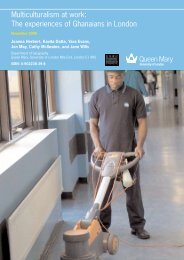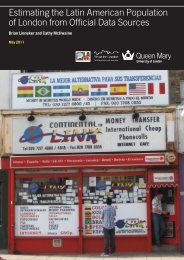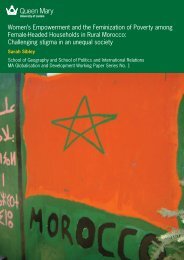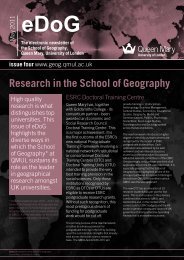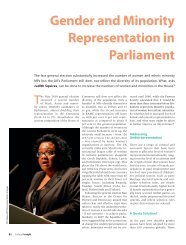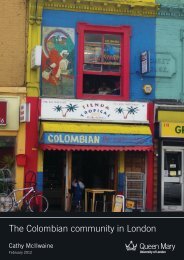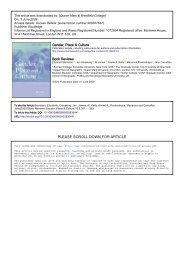Gender and Ethnic Identities among Low-paid Migrant Workers in ...
Gender and Ethnic Identities among Low-paid Migrant Workers in ...
Gender and Ethnic Identities among Low-paid Migrant Workers in ...
- No tags were found...
Create successful ePaper yourself
Turn your PDF publications into a flip-book with our unique Google optimized e-Paper software.
occupations which were also associated with a relatively high degree of gender stereotyp<strong>in</strong>g. With<br />
the exception of the construction sector which is a strongly mascul<strong>in</strong>ised workspace, care <strong>and</strong><br />
clean<strong>in</strong>g have rout<strong>in</strong>ely been viewed as ‘women’s work’. This reflects wider patterns <strong>in</strong> the UK<br />
labour market where jobs still tend to be def<strong>in</strong>ed as either ‘women’s’ or ‘men’s work’. For<br />
example, the Equal Opportunities Commission <strong>in</strong> the UK have noted that <strong>in</strong> 2002, just under half of<br />
women <strong>and</strong> just over half of men were <strong>in</strong> occupations where they outnumbered the opposite sex by<br />
at least two to one (Guerrier <strong>and</strong> Adib 2004). However, it has also been noted that there has been<br />
some movement towards men <strong>and</strong> women tak<strong>in</strong>g up more atypical work <strong>in</strong> the UK <strong>in</strong> terms of<br />
gender (Hakim 2000), <strong>and</strong> there has also been recognition that this is occurr<strong>in</strong>g more rapidly at the<br />
bottom <strong>and</strong> top ends of the labour market (Rubery 1996).<br />
At the same time, while it is now acknowledged that migrants are <strong>in</strong>creas<strong>in</strong>gly mov<strong>in</strong>g <strong>in</strong>to the<br />
lower echelons of predom<strong>in</strong>antly service sector occupations <strong>in</strong> the cities of the Global North<br />
(Sassen, 1991, 1996), little is known about how gender is negotiated between male <strong>and</strong> female<br />
migrants. Instead, the focus has tended to be on how migrant women have been <strong>in</strong>volved <strong>in</strong> ‘global<br />
care cha<strong>in</strong>s’ as they take over the reproductive work of middle-class women to allow them to go out<br />
to work (Ehrenreich <strong>and</strong> Hochschild [eds] 2002). This also has important ramifications for class<br />
ideologies <strong>and</strong> the construction of racial <strong>and</strong> ethnic identities (Matt<strong>in</strong>gly, 2001) (see below). While<br />
some research has begun to exam<strong>in</strong>e the experiences of women <strong>and</strong> men <strong>in</strong> non-traditional<br />
occupations <strong>in</strong> the UK (see Simpson 2004; Lupton 2000), this has not been considered <strong>in</strong> relation to<br />
low-<strong>paid</strong> migrant workers.<br />
To recall, our quantitative analysis highlights that significant gender stereotyp<strong>in</strong>g exist, but also that<br />
the general picture is much more complex than first appears. Although chambermaids <strong>and</strong> care<br />
workers were ma<strong>in</strong>ly women, migrant men were also employed <strong>in</strong> these occupations. In turn, men<br />
predom<strong>in</strong>ated <strong>in</strong> what are traditionally seen as ‘female-oriented’ occupations such as clean<strong>in</strong>g<br />
offices <strong>and</strong> on the London underground , as well as <strong>in</strong> the more traditional construction sector (see<br />
above). Thus, a complex process of negotiation occurs whereby gender <strong>in</strong>tersects with migrant<br />
status, as well as with ethnicity <strong>and</strong> class to create compound constructions of migrant identities <strong>in</strong><br />
the workplace (see also below). These at once re<strong>in</strong>force <strong>and</strong> subvert traditional gender <strong>and</strong><br />
occupational identities. This is made even more complex by the fact that migrants arrive <strong>in</strong> the UK<br />
labour market with identities <strong>in</strong>fluenced by their experiences <strong>in</strong> their home countries as Donato et<br />
al. (2006: 6) note: ‘<strong>Migrant</strong>s often become particularly aware of the relational <strong>and</strong> contextual nature<br />
13



